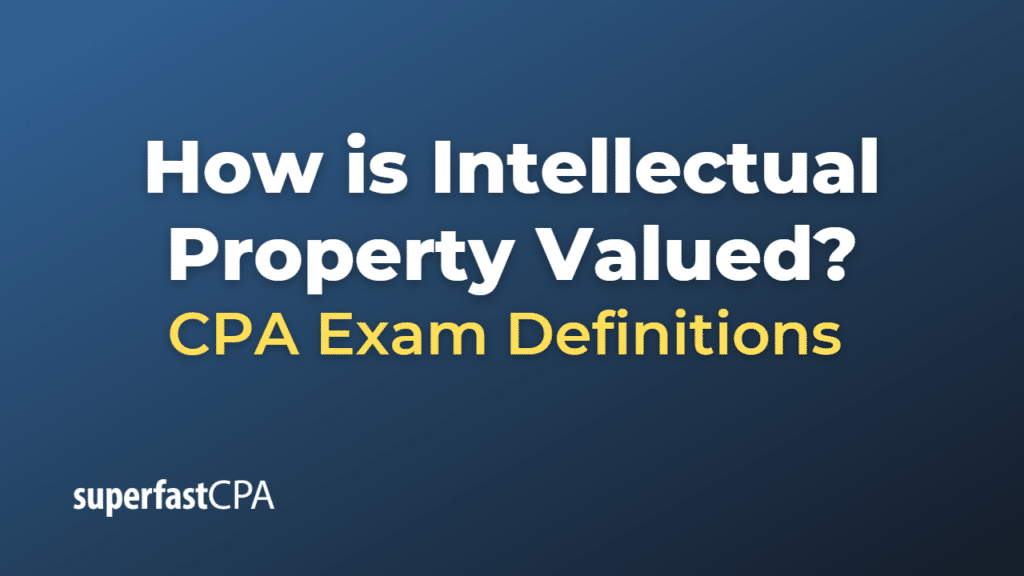How is Intellectual Property Valued
Valuing intellectual property (IP) can be a complex task due to its unique and intangible nature. However, it is essential for business transactions, litigation, accounting, and strategic planning purposes. Here are several methods commonly used to value IP:
- Cost Method: This method evaluates the cost of developing the IP, which includes research and development, prototyping, testing, and the cost of registering the IP (like the cost of obtaining a patent). Alternatively, it can assess the cost to recreate or replace the IP. This method does not necessarily reflect the current market value of the IP or its potential to generate revenue.
- Market Method: This method values IP based on what similar intellectual properties have sold for in the market. However, because every IP is unique and transactions involving similar IPs are not always publicly available, this method can be difficult to apply accurately.
- Income Method: This method is based on the expected future cash flows or profits that the IP will generate. The projected income is discounted back to the present value, using a discount rate appropriate for the risk of the projected income streams. This method can be quite complex but is often considered the most relevant if the IP generates or is expected to generate revenue.
- Relief from Royalty Method: This method estimates how much it would cost to license the IP if the company didn’t own it. This “relief from royalty” expense is then projected over the life of the IP and discounted back to the present value. This method is commonly used for valuing IPs like trademarks or patents that could be licensed out.
- Option Pricing Method: In certain cases where the future of the IP is highly uncertain, option pricing models used in financial markets (such as the Black-Scholes model) may be adapted to value the IP.
Note that the selection of the appropriate valuation method depends on the nature of the IP, the availability of data, the purpose of the valuation, and the standards of the jurisdiction in which the valuation is being performed. It’s also important to note that the valuation of IP is usually subject to significant uncertainties and assumptions about the future. Therefore, it’s often advisable to use multiple valuation methods and seek professional advice when conducting an IP valuation.
Example of How Intellectual Property is Valued
Let’s consider the example of a pharmaceutical company developing a new drug:
- Cost Method: The cost of developing the new drug can be calculated by adding up all the research and development costs, clinical trial costs, and the costs to obtain regulatory approval for the drug. These expenses would form the base value of the drug’s patent. However, this method does not account for the potential market success of the drug or its ability to generate future revenue.
- Market Method: The company could look at recent transactions involving similar drug patents to get an estimate of the market value. For instance, if a similar drug patent was recently sold for $50 million, this gives a rough idea of what the market might be willing to pay. However, this method can be challenging if comparable transactions are not available or if the drug is very unique.
- Income Method: If the drug is expected to generate $10 million in net profit annually for the next 20 years, these future profits could be used to calculate the present value of the patent. This involves discounting the future profits back to the present value using a suitable discount rate. This method would account for the future earning potential of the drug but would also involve assumptions about future sales, market conditions, and discount rates.
- Relief from Royalty Method: The company could estimate how much it would have to pay in royalties if it did not own the patent but instead licensed it from another company. If a typical royalty rate in the industry is 5% of sales, and the drug is expected to generate $200 million in sales annually, the avoided royalty cost would be $10 million per year. These annual savings could be projected over the life of the patent and discounted back to the present value to estimate the value of the patent.
- Option Pricing Method: If the future of the drug is highly uncertain, such as if it is still in early-stage trials or awaiting regulatory approval, an option pricing model could be used. This model would consider the potential upside if the drug is successful (the drug gets approved and sells well) and the potential downside if it is not (the drug does not get approved or fails in the market).
These are simplified examples and actual IP valuation would involve more complex considerations and detailed analysis. It’s important to note that the valuation of IP is subject to significant uncertainties and should be performed with the help of professionals experienced in IP valuation.













